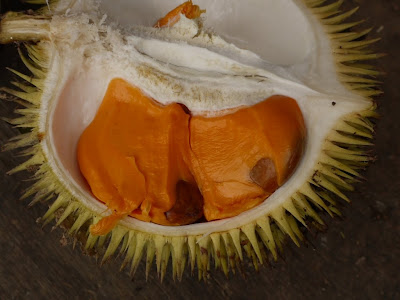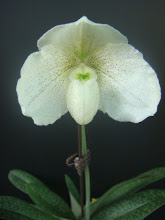Kota Kinabalu is full of interesting flora and fauna. These are some of my encounters.
Poring Hotspring AreaAn armored millipede which does not curl up when disturbed.
A green butterfly/moth which almost escaped my attention. It look just like the leaf on which it was standing, with patterns on its wings imitating the veins and white spots/patches on the leaf. Remarkable work of nature!!
Another strange looking butterfly/moth. This one has a blue horn!!
An interesting colony of wild ginger with its fruit very near to the ground.
Wild Durian!!
I have long been fascinated by pictures of the wild Red Durian of Borneo so it is high on my priority on this Sabah trip. Coincidentally, Durians are in season! However, every durian seller we met said that they either don't have the red variety or they have run out of it. This means that i must make another trip next year. I managed to get some other varieties of wild durians such as the white flesh and yellow flesh types. All of them are very round, smaller in size compared to commercial durian varieties and they have much longer spikes.
This is the white flesh variety. The wild durians don't smell as strong as the commercial durians and i could hardly smell anything near the stall.
It does not taste as strong as regular durians and the flesh is what we would term "dry", in fact "sticky dry". But it has the unmistable sweet durian aroma (if you love durians). So everybody can't wait to get their fingers sticky. It is a lovely treat.
Then of course there is the dark orange variety as well as the yellow variety. They taste different than the white variety but also very "sticky & dry".
Tarap
This is another of the 'must try' fruit when in Borneo. It can be found all year round and is related to the Jackfruit, Chempedak and Breadfruit (Sukun or Sokun). I know many people are not aware of the Breadfruit but somehow when i was young i knew it as Sokun from my kampong friends. Anyway, back to the Tarap; i am very sure we have it in Bukit Timah nature reserve. I remember seeing something similar when i was trekking along the paths.
The Tarap tastes sweet and the texture of the fruit is similar to Chempedak but does not have the strong Chempedak fragrance. It has a bit of very weak curry-leaf flavour mixed with the sweetness - very unique taste. A must-try fruit as well.
Rafflesia keithii
How can one go to Borneo without seeing the magnificent Rafflesia! We were so lucky that day cos the guide told us that there is one blooming just 1 minute walk away from the main road! People had to trek through the jungle and may not even see it! Furthermore it was a NEW BLOOM! It is Rafflesia Keithii.
Flies were hovering around the flower so they must have got the stench.









































